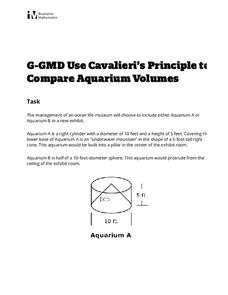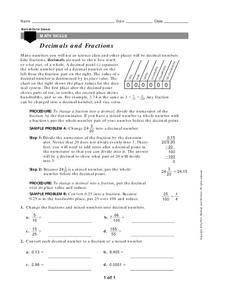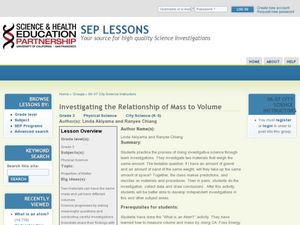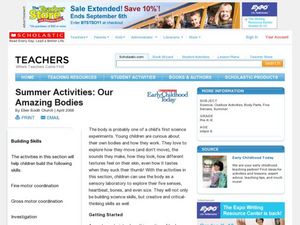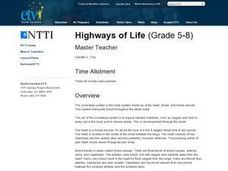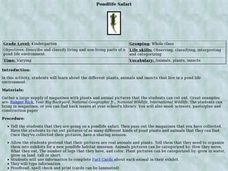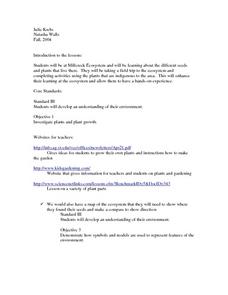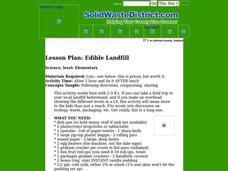Mary Pope Osborne, Classroom Adventures Program
Mummies in the Morning Egyptian pyramids, hieroglyphics
Visit the Magic Treehouse and take your class on a trip through time with a reading of the children's book Mummies in the Morning. Using the story to spark an investigation into Egyptian culture, this literature unit engages...
Curated OER
Plants and Ecosystems
The relationships within and between ecosystems can be explored. after examining an area for living and non-living things students complete the same examination in the forest ecosystem. Students identify abiotic and biotic elements in an...
Curated OER
Maggie's Adventures Grades 1-2
Students use Maggie's Learning Adventures online activity. They play a matching or memory game to become aware of homophones. Students recognize that there two ways to use many words. They practice with noun or verb identification by...
Illustrative Mathematics
Use Cavalieri’s Principle to Compare Aquarium Volumes
Learners are designing a stunning new water feature for an aquarium, but they soon discover that more than just a pretty home for their fishy friends is required. From calculating the volume of a composite shape through the...
Curated OER
Odyssey of Life, Part II-The Unknown World
Young scholars complete an experiment in which they observe different natural sample in which they uncover the microbial world. They complete a two part worksheet that accompanies the lesson.
College Board
2015 AP® Physics 1 Free-Response Questions
It's rare for even 40 percent of test takers to pass the AP Physics 1 exam. Improve those odds for young scientists with the help of actual free response questions covering topics from free body diagrams to velocity. The College Board...
Curated OER
Decimals and Fractions
In this decimals and fractions worksheet, students read about decimals and fractions and how to change one to the other. They solve two multi-part problems practicing converting decimals to fractions and fractions to decimals.
Curated OER
Coping with Changes
Students build on knowledge of brain and nervous system in order to write about how their nervous systems help them cope with change in environment. Students navigate online sites to explore different parts of brain and nervous system.
Curated OER
Investigating the Relationship of Mass to Volume
Third graders explore the relationship of mass to volume. In this physical science instructional activity, 3rd graders participate in an investigation with a several materials and measure the mass and volume using scientific tools....
Curated OER
Decimals in the Dugout
Students investigate place value and decimals during baseball related activities. In this place value activity, students explore place value with decimals. Resources are included.
Curated OER
The Bicycle as a System
For this bicycle as a system worksheet, students are assigned a subsystem of a bicycle, such as the wheel, the brakes and steering, or the frame. Each group of students identifies the parts, the function, the input, and the output of the...
Curated OER
Quicksand Questions: Short In-class Activity
Students are prompted with questions during a lecture on quicksand. Student answers can be collected with classroom response systems. The responses (both individual and the class as a whole) are recorded on the instructor's computer....
Curated OER
Summer Activities: Our Amazing Bodies
Students use the body as a sensory laboratory to explore their five senses, heartbeat, bones, and even size. In this early childhood science lesson, students build science and critical thinking skills as they take part in up to 6...
Curated OER
The Changing Me
Third graders study the human body. For this health lesson, 3rd graders discuss that everyone's body is growing, measure body parts using a tape measure, and color the body worksheet.
Curated OER
Highways of Life
Young scholars explore the circulatory system. They participate in media activities to explore blood flow and identify the parts of the circulatory sytem. Students create a model of the circulatory system.
Alabama Learning Exchange
Making and Observing Life in a Terrarium
Young scholars understand the parts of the terrarium and why they are important in establishing an ecosystem. In this ecosystem lesson, students recall background information on aquariums, terrariums and the water cycle. Young scholars...
Curated OER
What are Stars?
Students research the solar system and it's characteristics. For this solar system lesson, students are broken into 4 groups, each assigned a specific part of the solar system. Students use the Internet to research their part...
Curated OER
Too Cool for School-The Greenhouse Experiment
Learners create a town model and analyze the type of greenhouse gases their town emits. In this earth science lesson, students build greenhouses to investigate how trapped heat causes temperature change. They relate this activity to...
Curated OER
Veggie Chop and Data Analysis
First graders chop vegetables into fractions. In this fractions lesson plan, 1st graders cut vegetables, collect data about favorite vegetables and create a bar graph using the information. Students make inferences about the data...
Curated OER
Get into the Flow with an Interactive Volcano
Students research the structural elements of a volcano. They make a PowerPoint slide that contains five facts which will be added to a whole class slideshow. They add an interactive table of contents using action buttons.
Curated OER
The Fabulous Four
First graders examine the four seasons and identify appropriate attire for various seasonal activities. They listen to various books about each season, identify activities for each season, draw a picture of their favorite parts of the...
Curated OER
Pond-life Safari
Students determine the living and non-living parts of pond life. In this pond life lesson, students examine the plants, animals, and insects that live in ponds. They look through a variety of print media, cut out pictures, and arrange...
Curated OER
Ecosystem Field Trip
Students investigate the different seeds and plants that are part of the Millcreek ecosystem. They take a field trip to the ecosystem and complete activities using the plants that are indigenous to the area.
Curated OER
Edible Landfill
Students identify the parts of a landfill. In this ecology lesson, students use various ingredients to create an edible landfill snack. For example, students use fruit roll-ups for plastic liner and crushed graham crackers for gravel.



